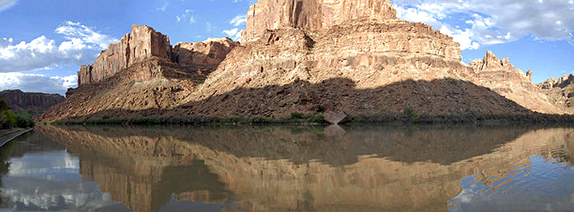
Here’s how a couple of tight-wad, do-it-yourself river amateurs managed to survive a four-day, 68-mile rafting trip in Labyrinth Canyon on the Green River in Utah.
We bought a cheap little raft online. It weights 60 pounds. It takes about 10 minutes to pump up. It holds four adult passengers. And during previous day trips on the Rio Grande in Colorado, the Rio Chama in New Mexico and several New Mexico lakes, it has proven to be well-nigh indestructible, bouncing effortlessly off boulders, grinding uneventfully over gravel and brushing off the sharpest overhanging branches.
We rendezvoused with a couple of friends in Moab, a ruined tourist trap in the center of the West’s most spectacular red-rock country. Then we drove an hour to Mineral Bottom on the Green River, where we left our car. The drive in is half-paved, half-dirt, with the last few miles a steep, narrow series of switchbacks plummeting almost vertically to the river far below.
Then we moved our boat and all our gear into our friends’ car and joined them for the two-hour drive to the village of Green River, some 50 miles northwest of Moab. After resting up overnight in your standard-issue motel, we drove 2 miles to Green River State Park, where we endured a long, mean-spirited lecture by a local ranger (whose colleague, however, turned to be easygoing and friendly). After forking over $20 for the privilege of parking a car there for four days, we unloaded our gear on the bank of the wide, muddy river.
Despite our best resolutions for an early start, it was after 10 a.m. by the time we hit the water. My wife and I lounged comfortably in our raft, while our friends perched at each end of their 16-foot, second-hand canoe, a new acquisition they were baptizing on this expedition. They reminded me of photos I’d seen of one-armed John Wesley Powell navigating the Colorado River rapids through the Grand Canyon while perched high in the raft’s prow in a wooden arm chair.
We quickly discovered some curious phenomena that would dominate the next four days of our lives.
Our little boat and the current carrying it along had minds of their own. Like our cat Ginseng whom we had left at home, the raft obeyed us when it cared to and ignored us when it suited it. Whenever we tried to go somewhere against the current, it proved impossible for one of us rowing alone and difficult even when both of us rowed. Meanwhile, our friends seemed to have no difficulty making their canoe go where they wanted it to, like an obedient, well trained puppy.
Another oddity of our little raft was that its default mode was to progress backwards. It liked to proceed downriver aft first. As soon as we stopped rowing, the back swung around of its own accord, probably because my wife and I sat side by side in the back of the boat, putting the greater weight there, with only our water, camping gear and food in the prow.
What started out being a petty annoyance became a delightful trademark of our passage, as we spent our most relaxed times looking at where we had just come from rather that at where we were going. The scenery in both directions was, after all, equally beautiful.
The Green in this section (but not in some other areas) is generally peaceful and meandering. Its route is so circuitous that the area has come to be called Labyrinth Canyon. At one point it circles back on itself for 7 miles, with the two sides of the circle so close that you can stand on a ridge between them and look down on both sides.
The wide river is lined with thick, lush trees and brush, giving it its name, although unfortunately most of the growth is salt cedar, which has succeeded in choking off native vegetation. In calmer areas, the green banks reflected onto the surface of the river. Above the banks rose steep cliffs of brilliant orange and red rocks. As we moved south, more and more often these cliffs descended directly into the water.
The water was very high, and we could see where recently it had been even higher, slicing away the banks of mud and sand. Here and there, islands with inviting beaches and groves of trees arose in the midst of the river. Beyond the red cliffs, high blue mountains could be glimpsed on the horizon. Close to hand, squawking groups of Canada geese and silent, lone, stilt-legged blue herons watched our passage.
When we hit a riffle or a stretch of faster current, the logistics of our raft’s movement downstream became particularly interesting, as the boat would frequently start swinging in wide, gentle circles. Especially if we put a paddle in the water to alter the boat’s angle of glide, the raft just delighted in going round and round.
The only alternative to our circling and backwardness was for both of us to row hard and steadily, which we did much of the time.
Rowing, however, came to seem more and more of an impediment rather than an assist to our journey, at best a minor adjunct to our floating progress downstream. The river was in full spate after several days of heavy rain in the mountains to the north and east, and it moved along at perhaps 3 or at times even 4 miles an hour without our having to do very much. The current was so fast, in fact, that to land the boat we would have to plan far in advance, maneuvering the raft close to shore and starting to drive hard with the oars well before our intended landing.
The longer we spent on the river, the more we were inclined to let the raft and the river have their way. They were, we realized, a kind of team, harnessed together to move us down the waterway. The more we fought their combination, the more we exhausted ourselves to only slight avail.
We thus learned not only to live with but to love our relative helplessness in the face of forces we could sometimes, with considerable effort, divert but never ignore. In living with these forces, we then had time and space to do otherwise than row, to see the cliffs and watch the herons, to look at each other and stare at the vast expanse of sky, to watch the water drift past, even to jump overboard and drift along in the fast current.
In the water, sometimes we held onto the boat or a rope. But sometimes we let ourselves go free, independent of the raft, drifting and swimming as a lone molecule in what, from that low perspective, seemed a great sea of a river. Sometimes a swimmer lagged behind the drifting boat, sometimes surged ahead of it.
Once my wife, a strong swimmer and former lifeguard, expected she would be swimming faster than the raft floated, only to discover she was far behind. The space between us grew despite her hardest strokes.
Our raft was in one of its most independent moods. Alone in the boat, I seemed unable either to stop it or to swing it into shore against the current. My every effort seemed to serve only to widen the distance between my wife and the raft. My wife was tiring. Our friends’ agile canoe swung in beside her, offering her help that she rejected. “Stop rowing,” she shouted to me, and after I did, she slowly overtook me.
Thus we discovered that the will of raft and river can be as troublesome as it is blissful, as perilous as it is propitious.
By the time we dragged our raft out of the river at Mineral Bottom on the fourth day, however, we had learned how to let ourselves drift in the arms of the current, how to float backward focusing on the scenery of the past, and how to travel in a circle. Most of all, I learned when to stop rowing.
(Photo by Jeff Foster)



Responses to “Rafting: The Art of the Circle”